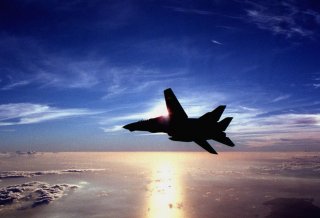Here’s What Happened When the F-14 Tomcat Eclipsed Advertised Max Speed
Mach 2.34 was supposed to be the limit. It wasn't.
The Northrop Grumman F-14 Tomcat—an American supersonic, twin-engine, two-seat, twin-tail, variable-sweep wing fighter—is unquestionably one of the most widely recognized aircraft in the U.S. Navy.
The fighter is armed with a General Electric Vulcan M61A-1 20mm gun with nearly seven hundred rounds of ammunition and possesses eight hardpoints for carrying ordnance—four on the fuselage and two on each side under the wings. It can also take along short, medium, and long-range air-to-air missiles AIM-9, AIM-7, and AIM-54, and air-to-ground ordnance that includes CBU cluster bombs.
A Highly Versatile Aircraft
According to Dario Leone at the Aviation Geek Club, “advancements during the Cold War in Soviet long-range patrol and bomber aircraft dictated a requirement for a fleet defense fighter that could engage high-altitude bombers from well beyond visual range.”
He continued: “The iconic F-14 Tomcat was Grumman’s answer. Needing an interceptor’s high speed while carrying this heavy ordnance, Grumman produced the highly effective variable sweep wing of the F-14, enabling it to operate at a wide range of airspeeds.”
Per the site, according to Charlie Brown, who was part of the F-14 design team and a Northrop Grumman test pilot, “the Navy specs called for a top speed of Mach 2.34, but the Tomcat was tested for Mach 2.5.”
‘Gone Past 2.5 Mach’
Dave Andersen, a former F-14 Tomcat Radar Intercept Officer (RIO) at the U.S. Navy, wrote on Quora that “back in the day, a typical U.S. Navy F-14 squadron was assigned twelve to thirteen jets at any given time. Of those, maybe two or three were stellar flyers. One or two were ‘hangar queens,’ seemingly always down for maintenance issues. And one or two were considered ‘bent’ … these jets wouldn’t trim up well and just didn’t fly very well compared to the other jets. The rest were somewhere in between in flying qualities.”
He continued: “To give an example, my squadron had one jet that was a real ‘hotrod.’ It always flew great, trimmed up perfectly, and out-accelerated and was faster than all the other jets in the squadron. Even the AWG-9 radar/weapons system worked better than the other jets. Everybody loved flying it. One of my most memorable flights was taking that one out on a post-maintenance check flight. When flying from our home base on land we would do these and other training flights in designated ‘restricted’ military training areas that were hundred miles or more out over the Atlantic Ocean east of the Virginia/North Carolina coast. The PMCF checklist called for a supersonic dash up to 1.2 Mach as one of the checks, so this being the squadron hotrod, of course, we decided to see what she’d do (despite the imposed NATOPS speed limit of 1.88 Mach).”
“So, we climbed to around 40K ft, pointed her east away from the coast, the pilot pushed the throttles into full burner, and we let her rip. That jet accelerated like it was blasted out of a cannon. In maybe fifty seconds we went from about four hundred knots and reached the advertised top speed of Mach 2.34, and the jet was still accelerating. I’m sure she would’ve gone past 2.5 Mach if we’d let her, but backed off at that point because we were getting close to ‘bingo’ fuel state,” he concluded.
Ethen Kim Lieser is a Washington state-based Science and Tech Editor who has held posts at Google, The Korea Herald, Lincoln Journal Star, AsianWeek, and Arirang TV. Follow or contact him on LinkedIn.
Image: Reuters

